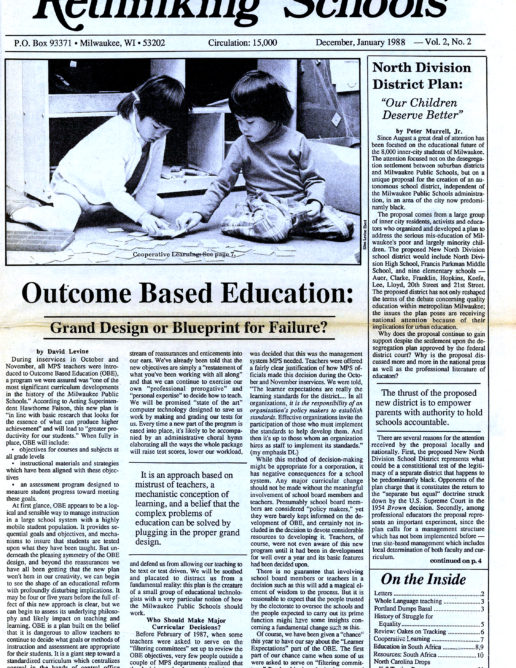School Making Differences
Keeping Track: How Schools Structure Inequality
Equal educational opportunity has generally been equated with desegregation in the decades since Brown v. Board of Education abolished state mandated separate schooling. When inequality of results has persisted in desegregated.schools, too often this disparity has been traced to an allegedly inferior home life said to impede the intellectual development of minority children. According to this perspective, it is not the fault of the schools if minority children do more poorly than their white peers. In her valuable book, Keeping Track, Jeannie. Oakes implicitly rejects this victim blaming point of view.
Rather than looking for inequality in the racial composition of schools or the family background of students, Oakes focuses on how educational practices of schools themselves create and perpetuate unequal educational outcomes for poor and minority students. She specifically examines the policy of tracking.
Oakes does not find malicious intent in tracking, a practice that has become so deeply embedded in high schools over the past half century that it seems to be an inevitable part of the instructional fabric. But Oakes does take issue with generally held beliefs that placement procedures for track assignments are fair and that tracking maximizes the educational development of all students. In fact, she argues that placement is capricious and that the quality of education differs by track so that those placed in high levels enjoy an enriched experience, while low track students suffer an impoverished one. Over time, then, vast disparities develop: in a perversion of affirmative action, those students classified as most needy get the fewest opportunities.
Placement into tracks, Oakes contends, is a dreadfully fallible process. In part, this is because norm-referenced tests are flawed instruments. Not only do they carry cultural biases, but they are designed in such a way that ranking of students takes precedence over assessing skills. Such tests, therefore, can only poorly measure achievement. Secondly, the often crucial recommendations of counselors tend to be unconsciously influenced by their assessment of students’ language, appearance, and manners, an assessment that is culturally conditioned as well. In the end, poor and minority students disproportionately end up in lower tracks. While it is hard to prove that placement is unfair, “what we can be quite sure of…,” Oakes points out, “is that the ability to learn is normally distributed among and within social groups.”
Others have written about the injustices of tracking, especially in work dating from the late 1960s and early 1970s when educational equality was a major national agenda item. Oakes goes further than her predecessors, however, by grounding her analysis in an exhaustive study of 297 classrooms in 25 schools. More than 150 research staff engaged in classroom observations, conducted interviews of school personnel, disseminated questionnaires to students and faculty, and compiled instructional materials. The resulting portrait of classroom life displays systematic differences in the experience of high and low track students.
High track students do much thinking and writing. They are asked to analyze, to develop alternative frameworks for interpreting phenomena, to peek beneath commonsensical views of the world in order to glimpse, underlying forces at work. They are expected to engage in expository writing, as well as to study literary genres and devices. They are urged to grasp the conceptual underpinnings of mathematical operations. Low track students, on the other hand, are occupied with workbooks and young-adult fiction; with grammar exercises and paragraph writing, with rote and arithmetic drill.
While Oakes finds neither high track nor low track classes electric with engagement between students and teachers, high track students-are advantaged not only by greater emphasis on intellectual development, but also by access to more prestigious content, by more homework, by more inspired teaching, and by more collegial relations in the classroom. While high track students are being prepared for university life and professional futures, low track students are being socialized for lives of labor.
Rather than narrowing disparities in performance, Oakes concludes, tracking expands them in ways that reproduce the inequalities of class and race in the social structure. She therefore maintains that the abolition of tracking will at least give all students equal opportunity to acquire the same prestigious knowledge- that affords access to higher education and occupational success. She insists that heterogeneous grouping will not retard the development of the quickest students and believes that a cooperative approach to learning would best serve the interests of all students in mixed classes.
Oakes’ solution is not without problems, however. By the time students reach high school unequal skill levels can be so drastic that heterogenous classes can be unwieldy at best. These inequalities result not only from less formal grouping in the earlier grades, but from a complex of curricular consent and educators attitudes that fails to affirm the power and promise of poor and minority children’s intellects. Oakes neglects to point out that untracked classes at the high school level are subject to the same abuses. Ultimately, the struggle for equal education must not only take on more subtle practices than tracking, but also the crude inequities in a social structure that tends to drive unequal education. Still Oakes has provided an invaluable service. By sharply delineating a significant way that “schools structure inequality,” she has created a starting point for dialogue and action that need not stop with the issue of tracking.

